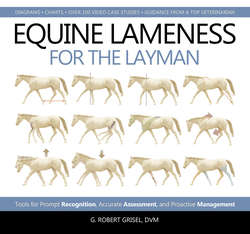Читать книгу Equine Lameness for the Layman - G. Robert Grisel DVM - Страница 24
На сайте Литреса книга снята с продажи.
P
ОглавлениеPain-Mediated Lameness: Altered movement(s) made in an attempt to avoid pain. Pain is invariably a consequence of local inflammation and/or nerve compression. As you might surmise, pain-mediated lameness hurts.
Palmar: Toward the back of the forelimb below the level of the carpus. “The navicular bone sits palmar to the coffin joint.”
Palmarolateral: Toward the back and outside of the forelimb below the level of the carpus. “The outside proximal sesamoid bone is positioned palmarolateral to the fetlock joint.”
Palmaromedial: Toward the back and inside of the forelimb below the level of the carpus. “The inside proximal sesamoid bone is positioned palmaromedial to the fetlock joint.”
Palpation: The examiner’s use of fingers and hands to physically perceive abnormality(ies) on or within the horse’s body and limbs.
Pathognomonic: Distinctively peculiar to a specific disease or condition.
Pathology: A disease process or the study of disease. Anything that is pathologic is abnormal.
Peak Vertical Force (PVF): The maximum vertical ground reaction force, which is encountered by each limb during mid-stance.
Pennate: A pattern of muscle tissue in which individual fiber bundles (called fascicles) attach obliquely (in a slanting array) to a common centralized tendon that runs the entire length of the structure. This pattern allows for higher force production but maintains a smaller range of motion.
Perineural: Near or adjacent to nerves.
Periosteum: A dense layer of connective tissue that covers bone.
Peripheral Lameness: Lameness associated with the horse’s extremities (limbs).
Peripheral Neurologic Lameness: Altered movement stemming from abnormal function of nerves outside of the brain and spinal column.
Periphery: The aspects of the horse located away from the center or midline. “The peripheral nervous system comprises the nerves and ganglia outside of the brain and spinal cord.”
Pisos: A term describing the quality of gait (e.g. timing, extension, animation, smoothness, elegance, and forward motion) demonstrated by the Peruvian Paso horse.
Plaiting: Technically means braiding. With respect to equine ambulation, plaiting refers to the way in which the limbs track during protraction; one foot is placed directly in front of the other. Often referred to as rope walking.
Plantar: Toward the back of the hind limb below the level of the tarsus. “The hind navicular bone sits plantar to the coffin joint.”
Plantarolateral: Toward the back and outside of the hind limb below the level of the tarsus. “The outside proximal sesamoid bone is positioned plantarolateral to the hind fetlock joint.”
Plantaromedial: Toward the back and inside of the hind limb below the level of the tarsus. “The inside proximal sesamoid bone is positioned plantaromedial to the hind fetlock joint.”
Posterior: Toward the rear of the horse. More appropriately denoted as caudal. “The horse’s pelvis is posterior to the withers.”
Prognosis: A forecast of the course of a disease or affliction. “High-motion joint disease often carries a guarded prognosis for future soundness in the performance horse.”
Protraction: The movement of a body part (e.g. a limb) in a forward direction.
Proximal: Toward the attached (upper) end of the limb. “The carpus is proximal to the fetlock joint.”
